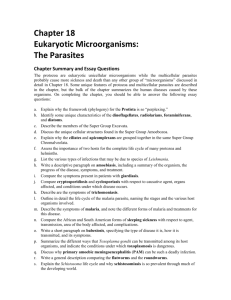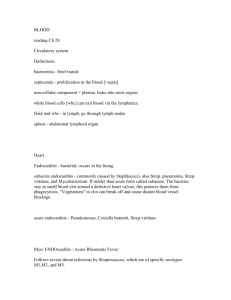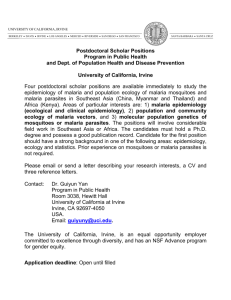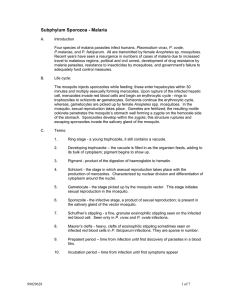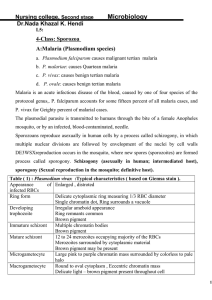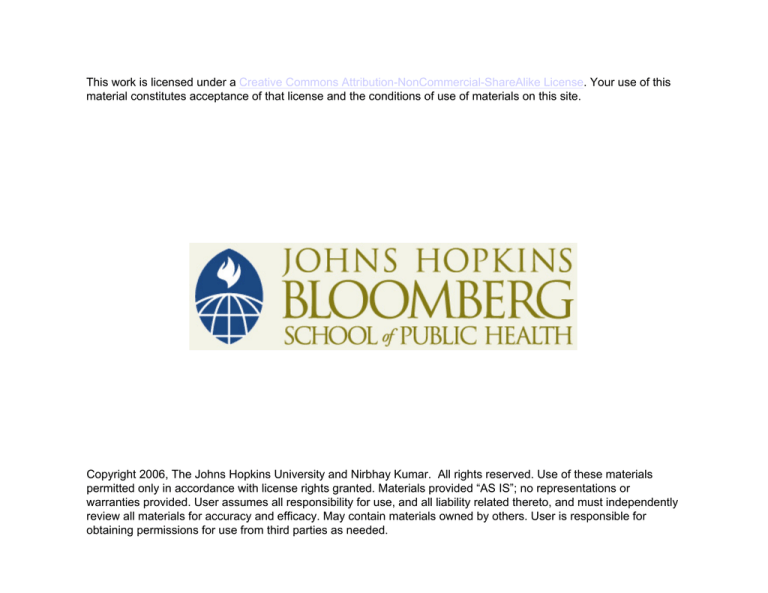
This work is licensed under a Creative Commons Attribution-NonCommercial-ShareAlike License. Your use of this
material constitutes acceptance of that license and the conditions of use of materials on this site.
Copyright 2006, The Johns Hopkins University and Nirbhay Kumar. All rights reserved. Use of these materials
permitted only in accordance with license rights granted. Materials provided “AS IS”; no representations or
warranties provided. User assumes all responsibility for use, and all liability related thereto, and must independently
review all materials for accuracy and efficacy. May contain materials owned by others. User is responsible for
obtaining permissions for use from third parties as needed.
Malariology: Biology of the Parasite
Nirbhay Kumar, PhD
Impact
• Worldwide
– >2.3 billion people at risk
– 300 to 500 million cases annually
– 1.5 to 2.7 million deaths annually
One death every 20 to 30 seconds,
somewhere in the world
Malaria: Plasmodium Species of
Human Disease
•
•
•
•
P. falciparum (malignant, TERTIAN)
P. vivax (benign, TERTIAN)
P. ovale (TERTIAN)
P. malariae (QUARTAN)
Malaria parasites are highly species
specific. No animal reservoir for human
malaria parasites.
The Infective stage (SPOROZOITE) transmitted
by female anopheline mosquito
Source: Nirbhay Kumar
• Sporozoites invade hepatocytes
– (t ½ < 30 minutes)
• Undergo asexual development over the
next 7-10 days
• Results in 20,000 – 30,000 fold increase
in parasite numbers
• Merozoites released then invade RBCs
(erythrocytes)
• P. vivax and P. ovale parasites produce
hypnozoites (dormant parasites) which
are responsible for relapse of malaria
Relapse versus Recrudescence
• Relapse: (P. vivax and P. ovale)
– Presence of dormant hypnozoites in the
liver
• Recrudescence: (All 4 species)
– Reappearance of blood forms of parasites
(drug resistance)
A Typical Asexual Cycle
•
Merozoites attach to rbc, orient to apical end, invaginate into RBC
by forming rbc membrane pocket called parisitophorous vacuole.
•
Merozoites invade RBCs and develop into ‘RING’ forms
•
Rings develop into TROPHOZOITES (contain microscopic heme
crystal)
•
Trophozoites replicate nuclear material to form SCHIZONTS (form
with more than one nucleus)
•
RBCs are lysed and Merozoites (12-32) released continue the RBC
cycle
•
(Tertian malaria – 48 hour cycle for Pf, Pv, Po), and (Quartan
malaria–72 hour cycle for Pm)
Classic Every Other Day Malaria Fevers
“Tertian” P. vivax
106
105
Temperature F
104
103
102
101
100
99
98
97
96
0
24
48
72
Hours
96
120
144
Adapted from Thayer and Hewetson
Johns Hopkins Hosp Reports V 1895 p. 3-224
Typical Malaria Paroxysms
• Three stages
– COLD: Chilly feeling followed by rising body
temperature (headache/nausea/vomit)
– HOT: High temperature 39 to 40.5 C
– SWEATING: Falling temperature is accompanied
by sweating (fatigue and weakness)
Pathological Complications of
P. falciparum Malaria
•
Uncomplicated
– Fever
– Parasitemia
– Anemia
•
Complicated (severe) malaria
–
–
–
–
–
–
–
–
Cerebral malaria (coma)
Severe anemia
Hypoglycemia
Renal failure
Electrolyte disturbances
Jaundice
Lactic acidosis
Etc. Etc.
Knobs on surface
Adherent parasites in brain
CDC/Dr. Melvin
Cytoadherence (Sequestration)
• Binding of TROPHOZOITE & SCHIZONT infected
RBCs to endothelial cells in post-capillary venuels in
the deep tissues.
• The binding is thought to be mediated by parasite
proteins in the electron-dense structures defined as
KNOBS
Rosetting
• Binding of RBCs containing parasites (mixed stages)
with uninfected RBCs
Malaria Parasites Use Two Hosts
• A human where it causes the disease
malaria
• A mosquito which it uses as a vector
Sexual Development
?
Asexual Stages
Sexual Stages
Gametocyte (male and female sexual
stages) development is crucial to
transmission
Exflagellation (Emergence of Male Gametes)
Female Gametocyte
Male
Gametocyte
ZY
G
O
TE
GAMETES
8 male gametes from a single gametocytes in <10 min
(XANTHURENIC ACID – exflagellation factor)
Source: Nirbhay Kumar
Innate Resistance Mechanisms
(Nonimmunological Mechanisms of
Refractoriness)
Hemoglobinopathies (>300 in humans, most
due to a single amino acid change in the
hemoglobin molecule)
• Hbs (sickle cell Hb), Autosomal recessive (β6 GLU to VAL)
• HbC (β-6 GLU to LYS)
• HbE (β-26 GLU to LYS)
• HbF (α/γ as compared to α/β in normal Hb)
• The Thalessemias (imbalance of α and β
globin chains)
Cont. . .
Innate Resistance Mechanisms
(Nonimmunological Mechanisms of
Refractoriness)
RBC enzyme deficiency
• Glucose-6-phosphate dehrdrogenase (G6PD)
RBC surface components
• Glycophorins (P. falciparum)
• Duffy blood group (P. vivax) (West Africana
are Duffy –ve)
RBC Cytoskeleton abnormalitiy
• (abnormal Band 3 protein)
• Ovalocytosis (elliptical red cells, PNG)
Cont. . .
Innate Resistance Mechanisms
(Nonimmunological Mechanisms of
Refractoriness)
Sickle-cell hemoglobin (HbS)
• SC – trait in heterozygotes (AS)
• SC- anemia in homozygotes (SS) (Fatal prior
to reproductive age)
• Gene frequency of AS is >>20% in Nigerian
population and ~10% in Afro-Americans
PARASITES DIE DUE TO LACK OF OXYGEN
and OTHER CAUSES

